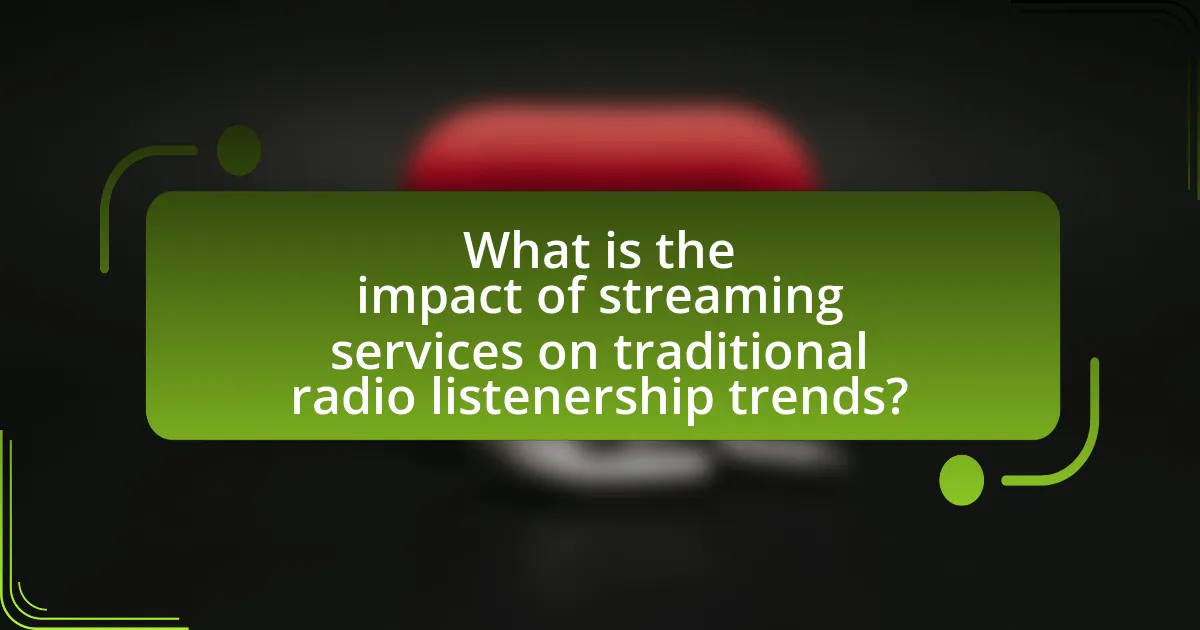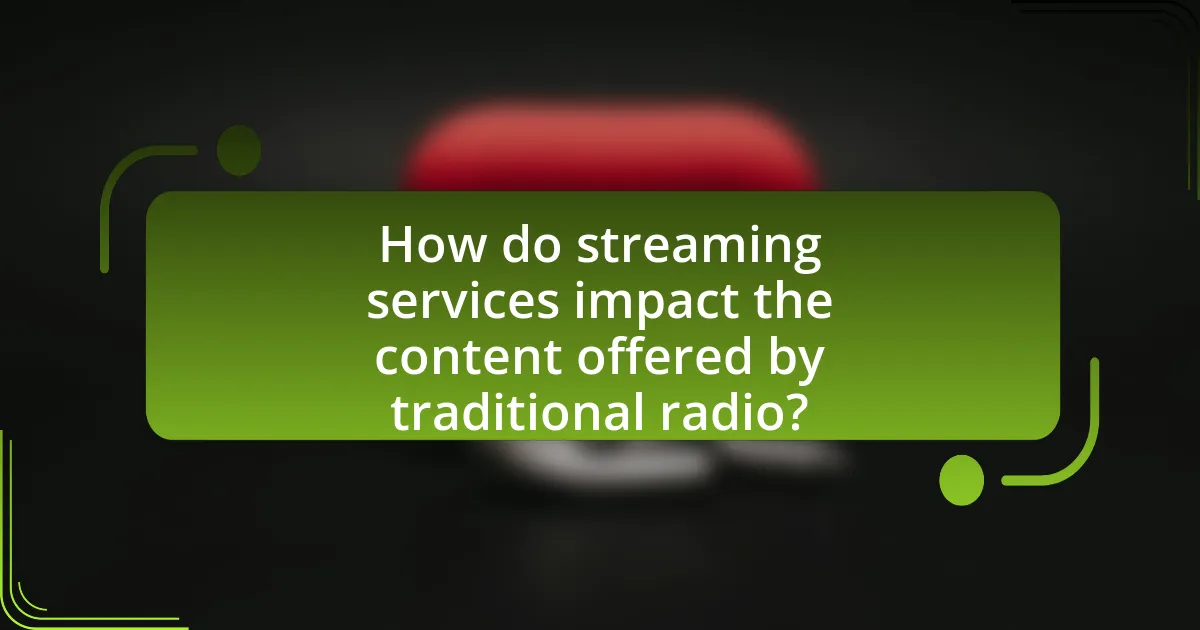The article examines the impact of streaming services on traditional radio listenership trends, highlighting a significant decline in radio audiences as consumers increasingly favor platforms like Spotify and Apple Music. Key findings indicate that traditional radio has experienced a 12% drop in average listening time from 2019 to 2021, with streaming accounting for 83% of the U.S. music industry’s revenue. The article explores how streaming services have transformed audio content consumption through personalized recommendations and on-demand access, leading to a demographic shift, particularly among younger audiences. Additionally, it discusses the challenges traditional radio faces, including declining advertising revenue and the need for digital integration to adapt to changing listener preferences.

What is the impact of streaming services on traditional radio listenership trends?
Streaming services have significantly decreased traditional radio listenership trends. According to a 2021 report by Nielsen, the average time spent listening to traditional radio dropped by 12% from 2019 to 2021, coinciding with the rise of platforms like Spotify and Apple Music, which offer personalized content and on-demand access. This shift indicates that consumers prefer the flexibility and variety provided by streaming services over the scheduled programming of traditional radio.
How have streaming services changed the way people consume audio content?
Streaming services have fundamentally transformed audio content consumption by providing on-demand access to a vast library of music, podcasts, and other audio formats. This shift allows users to listen to content anytime and anywhere, significantly reducing reliance on traditional radio schedules. According to a 2021 report by the Recording Industry Association of America, streaming accounted for 83% of the U.S. music industry’s revenue, highlighting the dominance of these platforms over conventional radio. Additionally, services like Spotify and Apple Music offer personalized playlists and recommendations, enhancing user engagement and satisfaction compared to the static programming of traditional radio.
What are the key features of streaming services that attract listeners?
The key features of streaming services that attract listeners include personalized content recommendations, on-demand access to a vast library of music and podcasts, and user-friendly interfaces. Personalized content recommendations utilize algorithms to analyze listener preferences, enhancing user engagement by suggesting relevant tracks or shows. On-demand access allows users to listen to their favorite content anytime, breaking the constraints of traditional radio schedules. Additionally, user-friendly interfaces simplify navigation, making it easier for listeners to discover new content. These features collectively contribute to the growing popularity of streaming services over traditional radio, as evidenced by a report from the Recording Industry Association of America, which noted that streaming accounted for 83% of the U.S. music industry’s revenue in 2022.
How do streaming services compare to traditional radio in terms of accessibility?
Streaming services offer greater accessibility compared to traditional radio. Users can access streaming platforms anytime and anywhere with an internet connection, while traditional radio is limited to specific geographic areas and requires a radio receiver. According to a 2021 report by the Pew Research Center, 53% of Americans listen to music through streaming services, highlighting the shift towards more accessible audio content. Additionally, streaming services provide personalized playlists and on-demand content, further enhancing user accessibility compared to the fixed programming of traditional radio.
Why are listeners shifting from traditional radio to streaming services?
Listeners are shifting from traditional radio to streaming services primarily due to the demand for personalized content and on-demand access. Streaming services offer users the ability to choose specific songs, create playlists, and listen to music anytime, unlike traditional radio, which follows a fixed schedule and programming. According to a 2021 report by the Pew Research Center, 61% of Americans aged 18 to 29 prefer streaming services over traditional radio, highlighting a significant generational shift in media consumption habits. This preference is further supported by the convenience and variety that streaming platforms provide, allowing listeners to explore diverse genres and artists without the limitations of radio broadcasting.
What demographic trends are evident in the shift from radio to streaming?
The demographic trends evident in the shift from radio to streaming include a significant increase in usage among younger audiences, particularly those aged 18 to 34. This age group has shown a preference for on-demand content, with 70% of millennials and Gen Z listeners favoring streaming services over traditional radio, according to a 2021 Nielsen report. Additionally, urban populations are more likely to adopt streaming, reflecting a broader trend of digital media consumption in metropolitan areas. This shift is further supported by the rise of mobile device usage, with 85% of streaming listeners accessing content via smartphones, highlighting the changing landscape of media consumption.
How do listener preferences influence this transition?
Listener preferences significantly influence the transition from traditional radio to streaming services by driving demand for personalized and on-demand content. As listeners increasingly favor tailored experiences, streaming platforms have adapted by offering curated playlists, algorithm-driven recommendations, and the ability to choose specific tracks or genres, which traditional radio cannot provide. Research indicates that 63% of listeners prefer streaming services for their ability to customize listening experiences, highlighting a clear shift in consumer behavior towards platforms that prioritize individual preferences over scheduled programming. This shift in listener preferences is reshaping the audio landscape, leading to a decline in traditional radio listenership as audiences seek more control over their media consumption.
What challenges do traditional radio stations face due to streaming services?
Traditional radio stations face significant challenges from streaming services, primarily due to competition for audience attention and advertising revenue. Streaming platforms like Spotify and Apple Music offer personalized content and on-demand access, which attracts listeners away from traditional radio. According to a 2021 report by Nielsen, 62% of Americans aged 18-34 prefer streaming services for music consumption, highlighting a demographic shift that traditional radio struggles to retain. Additionally, streaming services often provide targeted advertising, which is more appealing to advertisers compared to the broad reach of traditional radio, leading to a decline in ad revenue for radio stations. This shift in listener preferences and advertising dynamics poses a substantial threat to the viability of traditional radio in the evolving media landscape.
How has advertising revenue been affected by the rise of streaming?
Advertising revenue has declined due to the rise of streaming services. Traditional media, particularly radio and television, has experienced a significant drop in ad spending as audiences shift to on-demand streaming platforms like Netflix and Spotify, which often feature ad-free options. According to a report by eMarketer, U.S. digital ad spending surpassed traditional media for the first time in 2020, highlighting the growing preference for streaming content over traditional broadcasts. This shift has led advertisers to reallocate budgets towards digital platforms, further impacting the revenue of traditional advertising channels.
What strategies are traditional radio stations employing to adapt?
Traditional radio stations are employing digital integration and content diversification strategies to adapt to the rise of streaming services. By launching online streaming platforms and mobile apps, these stations are reaching audiences beyond their geographical limitations, thus increasing their listenership. Additionally, they are creating on-demand content and podcasts to cater to changing consumer preferences for personalized listening experiences. According to a 2022 Nielsen report, 62% of radio listeners also engage with streaming services, highlighting the necessity for traditional stations to evolve.

How do streaming services impact the content offered by traditional radio?
Streaming services significantly influence the content offered by traditional radio by shifting listener preferences towards on-demand and personalized audio experiences. As audiences increasingly favor platforms like Spotify and Apple Music, traditional radio stations adapt by diversifying their playlists and incorporating more popular music trends to retain listeners. For instance, a Nielsen report from 2021 indicated that 60% of U.S. adults now prefer streaming services for music consumption, prompting radio stations to adjust their programming to include trending songs and genres that appeal to this audience. This shift not only affects the types of music played but also encourages radio to explore niche content and podcasts, aiming to compete with the tailored experiences provided by streaming platforms.
What types of content are more popular on streaming platforms compared to traditional radio?
Streaming platforms are more popular for on-demand music, podcasts, and original content compared to traditional radio. On-demand music allows users to select specific songs or albums, catering to individual preferences, while traditional radio typically follows a set playlist. Podcasts have surged in popularity on streaming platforms, with over 50% of U.S. households reportedly listening to podcasts, compared to limited availability on radio. Additionally, original content, such as exclusive shows and series, attracts audiences seeking unique programming that traditional radio cannot provide. These trends indicate a significant shift in listener preferences towards personalized and diverse content offerings on streaming platforms.
How does the availability of on-demand content influence listener choices?
The availability of on-demand content significantly influences listener choices by providing greater flexibility and personalization in media consumption. Listeners can select specific shows, songs, or genres at their convenience, which contrasts with traditional radio’s scheduled programming. Research indicates that 78% of consumers prefer on-demand services for their ability to curate content according to individual preferences, leading to a decline in traditional radio listenership. This shift is further supported by the rise of platforms like Spotify and Apple Music, which offer tailored playlists and recommendations, enhancing user engagement and satisfaction.
What role does podcasting play in the competition with traditional radio?
Podcasting significantly enhances competition with traditional radio by offering on-demand content that caters to diverse listener preferences. Unlike traditional radio, which follows a fixed schedule, podcasts allow users to choose when and what to listen to, leading to increased engagement. According to Edison Research’s “The Infinite Dial 2023,” 62% of Americans aged 12 and older reported listening to a podcast in the past year, indicating a growing audience that traditional radio struggles to capture. This shift in listener behavior demonstrates that podcasting not only attracts a younger demographic but also provides niche content that traditional radio often overlooks, further intensifying the competition.
How are traditional radio stations responding to the content trends set by streaming services?
Traditional radio stations are adapting to the content trends set by streaming services by incorporating on-demand programming and personalized playlists. This shift is evident as many radio stations now offer podcasts and streaming options that allow listeners to choose content that fits their preferences, similar to platforms like Spotify and Apple Music. According to a 2022 Nielsen report, 60% of radio listeners also engage with streaming services, prompting traditional stations to enhance their digital presence and diversify their content offerings to retain audience engagement.
What innovative programming strategies are being adopted by radio stations?
Radio stations are adopting innovative programming strategies such as personalized content curation, interactive listener engagement, and integration of digital platforms. Personalized content curation allows stations to tailor playlists and programming to individual listener preferences, enhancing user experience and retention. Interactive listener engagement includes real-time feedback mechanisms through social media and mobile apps, enabling audiences to influence programming decisions. Additionally, the integration of digital platforms, such as podcasts and streaming services, expands reach and caters to on-demand listening habits, which have been increasingly popular due to the rise of streaming services. These strategies are essential for radio stations to remain competitive and relevant in a landscape heavily influenced by digital media consumption trends.
How are collaborations between radio and streaming services evolving?
Collaborations between radio and streaming services are evolving through strategic partnerships that enhance content distribution and audience engagement. For instance, many radio stations are now integrating their broadcasts with streaming platforms to reach wider audiences, allowing listeners to access live shows and curated playlists online. This trend is supported by data indicating that over 50% of radio stations in the U.S. have adopted streaming services to complement their traditional broadcasts, thereby increasing their listener base and adapting to changing consumer preferences. Additionally, streaming services are leveraging radio’s established brand presence to promote exclusive content, creating a symbiotic relationship that benefits both entities.

What are the future implications of streaming services on traditional radio listenership trends?
Streaming services are likely to continue diminishing traditional radio listenership trends. As of 2023, data shows that over 80% of Americans aged 18-34 prefer streaming platforms for music consumption, indicating a significant shift in audience preferences. This trend is reinforced by the increasing availability of personalized playlists and on-demand content, which traditional radio cannot match. Furthermore, a report from Nielsen indicates that radio listenership has declined by approximately 20% over the past decade, correlating with the rise of streaming services like Spotify and Apple Music. As streaming services evolve and expand their offerings, traditional radio may face further challenges in retaining its audience.
How might technological advancements further influence listener habits?
Technological advancements will likely enhance listener habits by increasing accessibility and personalization of audio content. For instance, the rise of artificial intelligence in streaming services allows for tailored recommendations based on individual listening patterns, which can lead to increased engagement. According to a 2022 report by the International Federation of the Phonographic Industry, 85% of users prefer platforms that offer personalized playlists, demonstrating a clear shift in listener preferences driven by technology. Additionally, advancements in mobile technology and internet connectivity enable listeners to access content anytime and anywhere, further transforming how and when they consume audio.
What emerging technologies could reshape the audio landscape?
Emerging technologies that could reshape the audio landscape include artificial intelligence, spatial audio, and blockchain. Artificial intelligence enhances content personalization and automated audio production, allowing for tailored listening experiences. Spatial audio technology creates immersive sound environments, transforming how users perceive audio content. Blockchain offers decentralized platforms for content distribution, ensuring fair compensation for creators and enhancing transparency in the audio industry. These technologies are already influencing trends, as evidenced by the rise of AI-driven music recommendation systems and the increasing adoption of spatial audio in streaming services.
How can traditional radio leverage technology to retain listeners?
Traditional radio can leverage technology to retain listeners by integrating digital platforms and enhancing interactivity. By adopting streaming services, radio stations can reach a broader audience beyond geographical limitations, as evidenced by a Nielsen report indicating that 62% of Americans listen to online radio. Additionally, utilizing social media for real-time engagement allows listeners to interact with hosts and participate in polls or contests, fostering a sense of community. Implementing mobile apps can also provide on-demand content, catering to the preferences of younger audiences who favor convenience, as shown by a study from Edison Research that highlights the increasing trend of podcast consumption among younger demographics.
What best practices can traditional radio stations adopt to thrive alongside streaming services?
Traditional radio stations can thrive alongside streaming services by enhancing their digital presence and offering unique content. By developing mobile apps and engaging websites, radio stations can provide listeners with on-demand access to shows and exclusive content, which is essential in a digital-first environment. According to a Nielsen report, 60% of radio listeners also use streaming services, indicating a need for radio to adapt to listener preferences. Additionally, incorporating interactive elements such as social media engagement and listener polls can foster community and loyalty, which streaming services often lack. Furthermore, focusing on local content and live events can differentiate traditional radio from streaming platforms, as 75% of listeners value local news and music. These strategies can help traditional radio stations maintain relevance and grow their audience in the competitive landscape shaped by streaming services.
How can radio stations enhance listener engagement in a streaming-dominated market?
Radio stations can enhance listener engagement in a streaming-dominated market by leveraging interactive content and personalized experiences. By incorporating real-time listener feedback through social media, text messaging, and mobile apps, radio stations can create a two-way communication channel that fosters community involvement. For instance, a study by Nielsen found that 60% of listeners prefer stations that engage them through social media interactions. Additionally, offering on-demand content and curated playlists can cater to individual preferences, making the listening experience more relevant and appealing. This approach not only retains existing listeners but also attracts new audiences who seek personalized media consumption.
What role does community involvement play in maintaining a loyal listener base?
Community involvement is crucial for maintaining a loyal listener base as it fosters a sense of belonging and connection among listeners. Engaging with the community through events, local news, and listener feedback creates a two-way relationship that enhances listener loyalty. Research indicates that radio stations that actively participate in community activities see a 30% increase in listener retention compared to those that do not engage locally. This involvement not only strengthens the emotional ties between the station and its audience but also encourages word-of-mouth promotion, further solidifying the listener base.


